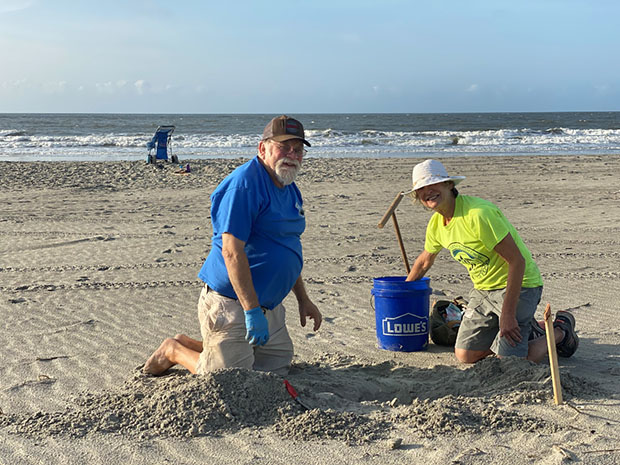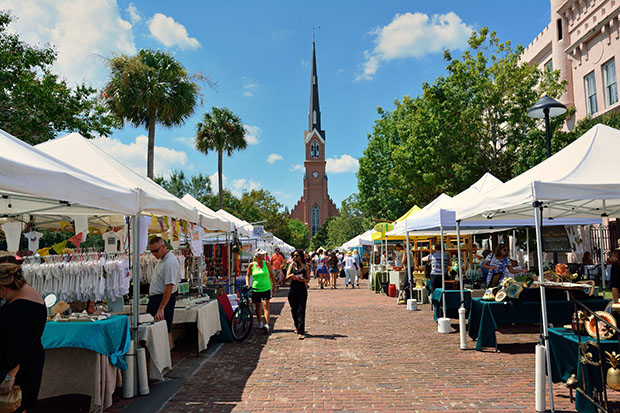Turtles Crossing
05 Jul 2021
A day in the life of a Folly Beach Turtle Watch volunteer
By Jenny Peterson

It’s 6 a.m. and dawn is just breaking at the Folly Beach County Park. By noon, hundreds of beachgoers will have arrived, but at this hour there’s only two people walking carefully along the shoreline, eyes on the ground.
James Island residents Bob and Pat Gaylor make the same walk each week for four months, pushing a beach cart filled with unusual items—bright orange signs, wooden stakes and orange tape.
They walk this area of the beach with one goal: to report any observed overnight activity from loggerhead Sea Turtles, one of the ocean’s endangered species.
An annual nighttime occurrence along the East Coast, loggerhead sea turtles swim onshore from May-October, digging a nest in the sand with their flippers and laying upwards of 100 eggs before heading back to the ocean.
The Gaylors are among 65 volunteers who keep a close eye on the nests as members of the Folly Beach Turtle Watch Program. They are the unsung heroes for loggerhead Sea Turtles, patrolling every inch of Folly’s six-mile beach during turtle nesting season making sure the hatchlings have the best chance of survival. Their duties include picking up trash, filling in holes and flattening sandcastles.
Two years ago, volunteers recorded a record-breaking 145 nests on Folly Beach, with meticulous data sent to the South Carolina Department of Natural Resources.
In June, the Gaylors had their first discovery of the season on one of their early morning patrols: the telltale tracks of a female loggerhead turtle, tiny treads in the sand.
Bob Gaylor used a wooden dowel to confirm the presence of a nest, carefully probing the sand around where the turtle tracks stopped.
“We carefully push the dowel into the sand every 3-5 inches in the area and if the dowel suddenly sinks, that’s where the cavity is where the eggs were laid,” Pat Gaylor said.
It took about ten minutes to locate this particular nest, the 25th reported loggerhead sea turtle nest on Folly Beach for the 2021 season.
This nest, however, had a problem; it was laid below the high tide line. If left where it was, the eggs would likely perish and wash into the ocean.
The Gaylors had to move quickly to beat the heat as they dug up all 115 eggs in the nest, carefully placing them into a bucket and relocating them to higher ground.
“At one point, Bob had to lay down in the sand to dig an entire arm’s length deep,” Pat Gaylor said.
Once the eggs were safely moved, the area was cordoned off with wooden stakes, tape and an official sign: Loggerhead Turtle Nesting Area.
An Endangered Species
The Turtle Watch organization formed over a decade ago, with a mission to help protect the endangered species and give the eggs the best chance for survival.
Teresa Marshall, a Folly Beach council member who heads up the Folly Beach Turtle Watch Program, walks the beach four days a week and is on call every day as early as 5:30 a.m. waiting for updates from the volunteers.
In her eight years at the helm, she’s helped identify and relocate countless nests (about half the nests need to be moved) and she’s even watched a 250-pound mother turtle lay eggs from start to finish.
Despite laying between 110-135 eggs per nest, only about 1 in 1,000 loggerhead sea turtles will survive into adulthood.
Hazards include blistering heat that eggs can’t tolerate, wildlife disturbing the nests and human behavior, like leaving on exterior beachfront lights at beachfront properties, which disorient the turtles. Folly Beach has an ordinance in place about turning lights off during nesting season. Marshall said that construction crews working on the Folly Beach Pier this season will also minimizing lights and noise—and also keep an eye out for tracks.
Despite the odds, the hatchlings generally emerge at night, and as a group, they begin their crawl towards the ocean.
The Turtle Watch volunteers then converge on the nest the following day, taking inventory of how many eggs were in each nest, how many survived, and give any live hatchlings a loving nudge into the ocean.
Their meticulous data helps SCDNR get a snapshot of the sea turtle population year after year, and volunteers often send pieces of shells to the agency for DNA testing, to see if the mother had previously laid a nest.
“It’s a thrilling thing to do,” Marshall said. “It’s all about the conservation of the turtles, protecting their nests and protecting this endangered species.”
For more information on the Folly Beach Turtle Watch Program, visit www.facebook.com/follyturtles












